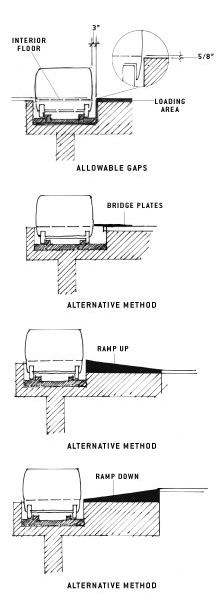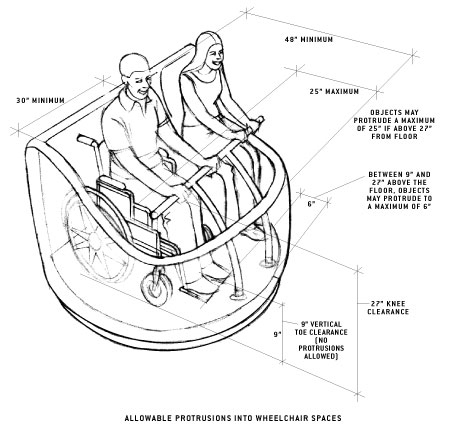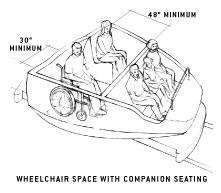Accessible Amusement Rides - A Summary of Accessibility Guidelines for Recreation Facilities
Amusement Rides with Wheelchair Spaces
Minimum space requirements and clearances for wheelchairs are specified where a ride provides a wheelchair space. If possible, designers and manufacturers should incorporate more space to enhance the ease of loading and unloading and to accommodate a greater variety of personal mobility devices.
Approach
Turning space (60-inch diameter or T-shaped space) for a wheelchair must be provided where the accessible route adjoins the ride, so that riders can access the ride. One side of the wheelchair space must adjoin an accessible route. The turning space may overlap the accessible route and the required clear floor space.
Load and Unload Areas
The floor or ground surface in the load and unload areas must have a slope not steeper than 1:48 and be stable, firm, and slip resistant.
Gaps
Where wheelchair spaces are provided on amusement rides, the floors of rides must be coordinated with the floors of the load and unload areas so that when the ride is at the load and unload position, the vertical differences between the two floors are within 5/8 inch and the horizontal gap is not more than 3 inches, under normal conditions.
However, if compliance with those measurements is not operationally or structurally feasible, operators may use bridge plates, ramps or other devices. They must comply with the Board’s vehicle guidelines (36 CFR 1192.83 (c).
Clearances
Wheelchair spaces on amusement rides must comply with the following provisions, with three exceptions:
-
Securement devices may overlap required clearances.
-
The wheelchair spaces may be mechanically or manually repositioned, for example, using a turntable.
-
There is no clear headroom requirement for wheelchair spaces on a ride since many rides move through confined spaces. The 80-inch minimum vertical clearance requirement remains for circulation areas and accessible routes in the queue line and load and unload areas.
Openings, Width and Length of Wheelchair Space
Openings and the width and length of wheelchair spaces need to be considered in relation to each other. Openings on rides that provide wheelchair spaces must be at least 32 inches wide. This minimum width is necessary for passage of a wheelchair or mobility device.
Wheelchair spaces must have a clear width of 30 inches minimum and a clear length of 48 inches minimum, measured to at least 9 inches above the floor surface. Wheelchair access can be provided onto the ride vehicle in many ways, including, but not limited to, rear entry, side entry, or side entry with a turntable.
Side Entry Openings, and Width and Length of Wheelchair Space
If the wheelchair space can only be entered from the side, the ride must be designed to permit sufficient turning space for people using a wheelchair or mobility device to enter and exit the ride. Designers must consider the position of the opening in relation to the wheelchair space and add clear space and larger openings as necessary. For example, an opening of 32 inches, combined with a 30-by-48-inch minimum wheelchair space, is not enough space for turning to face the front of the ride vehicle. If there is a 42-inch opening, a wheelchair space with a clear length of 60 inches minimum and a clear width of 36 inches minimum would be needed.
Protrusions
There may be some protrusions into wheelchair spaces on rides, but not into circulation areas, accessible routes,or load and unload areas. Where a wheelchair space is located on a ride, nothing may protrude into the front of the wheelchair space 9 inches from the floor. Objects may protrude into the space a maximum of 6 inches along the front of the space, if they are between 9 inches and 27 inches maximum above the floor. Objects may protrude a maximum of 25 inches along the front of the space if they are more than 27 inches above the floor surface.
Companion Seats
Where companion seating is provided on a ride, companion seating adjacent to wheelchair spaces is also required in some cases. A companion seat is required if the interior of an amusement ride is more than 53 inches wide, there is seating for more than one rider, and the wheelchair doesn’t need to be centered within the ride to maintain the center of gravity.
If the ride has shoulder-to-shoulder seating, the companion seating must be shoulder-to-shoulder with the adjacent wheelchair space. If shoulder-to-shoulder companion seating is not operationally or structurally feasible (i.e., in water rides where the rider’s center of gravity is critical) operators must comply with this provision to the maximum extent feasible.




User Comments/Questions
Add Comment/Question